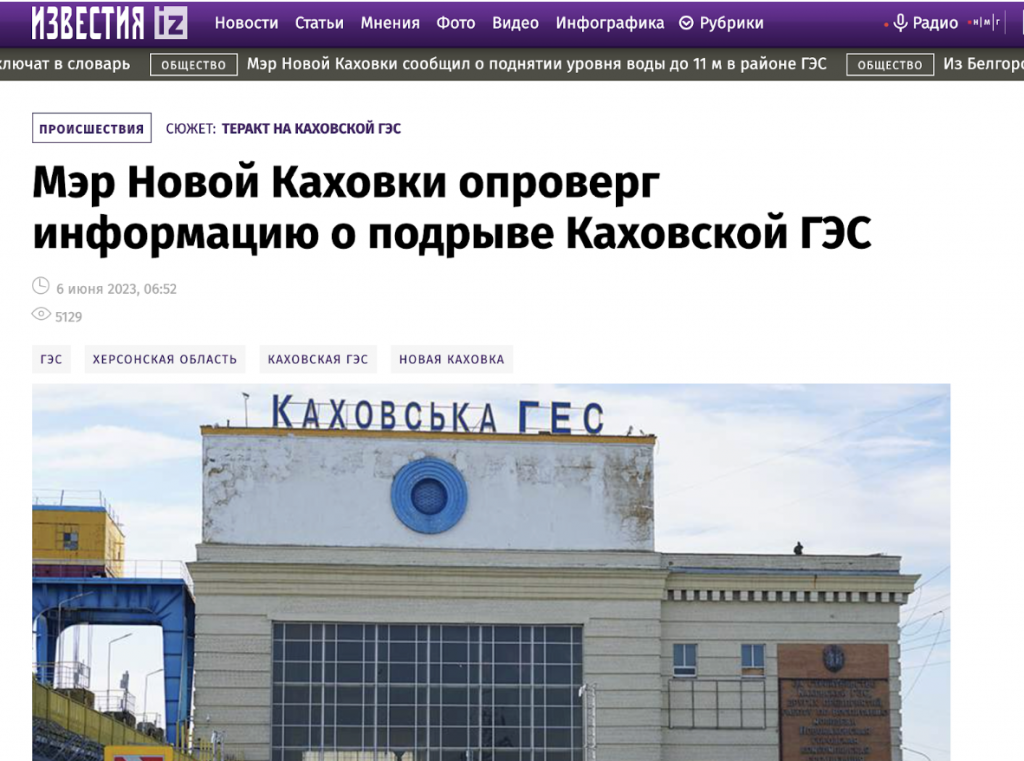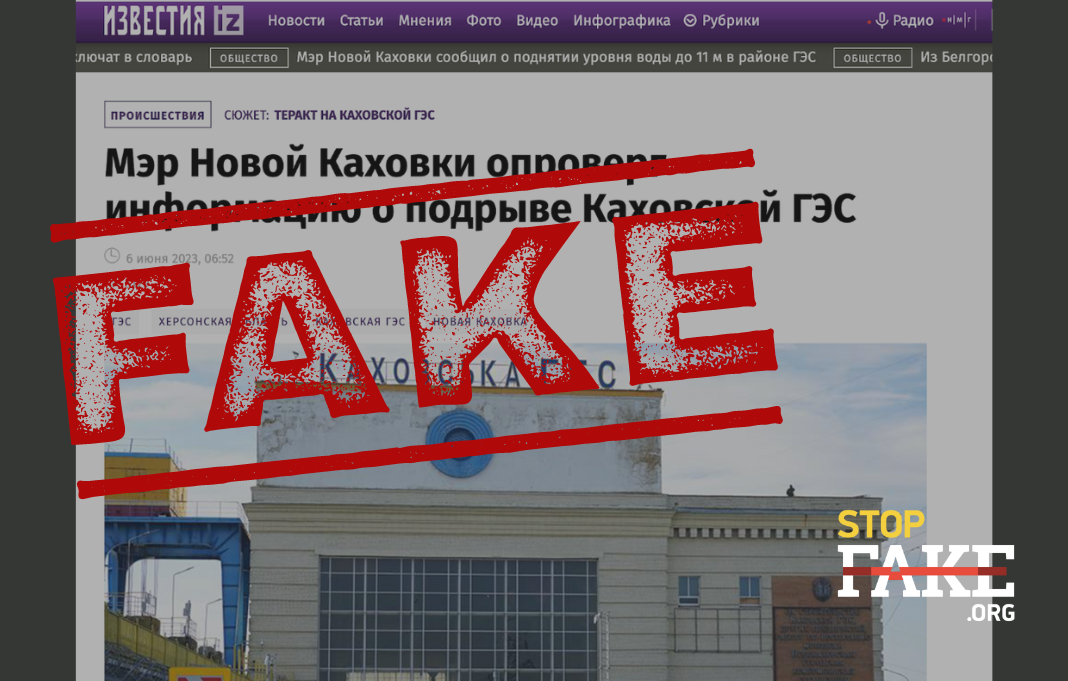Ukraine did not destroy its own hydroelectric power station, creating a man-made disaster on its territory. Since 2022, the Kakhovka hydroelectric power plant has been under Russian occupation – it was the Russian army that mined the plant’s units back in the autumn of 2022. On June 6, 2023, simultaneously with massive missile attacks on Ukrainian cities, the Russian army carried out a remote detonation of the Kakhovka plant.
In the early hours of June 6, alongside another massive missile attack on Ukrainian cities, Russian invaders blew up the Kakhovka hydroelectric power station they had originally seized in early 2022. According to Ukraine’s President Volodymyr Zelensky, the occupying troops carried out an internal explosion of the dam’s structures at 02:50 am. Some 80 towns and villages are located in the flood zone, tens of thousands of people are at risk.
Despite the huge number of photos and video materials confirming the Ukrainian authorities’ announcement about the Kakhovka facility being damaged by Russian forces, at first Russian media assured that “everything is quiet and calm in Nova Kakhovka”, and information about damage to the dam is “nonsense”. When it became impossible to hide the fact of the disaster, pro-Kremlin media began flooding the airwaves and the internet with a huge number of disparate theories about the destruction of the Kakhovka dam – from the narrative that “the dam collapsed on its own” to “Ukrainian missiles bombing the Kakhovka station.” StopFake journalists collected the five leading versions about the dam’s destruction that the Russian media are tirelessly pedaling.

Fake #1: Ukraine destroyed the Kakhovka dam by launching a strike with Vilkha rocket system.
Fact: Ukraine did not destroy its own hydroelectric power station, thereby endangering the lives of thousands of peaceful Ukrainian civilians and generating a man-made disaster on Ukrainian territory. The dam was captured by Russia at the start of Moscow’s February 24,2022 invasion of Ukraine and has been held by Russian forces ever since, fully controlling the strategic facility and everything that happens there.
Ukraine’s Armed Forces Southern Operational Command were the first to inform about the breach at the Kakhovka dam. Russian media at that time tried to hush up the topic, claiming the Ukrainian army was disseminating “disinformation.” As Ukrainian authorities declared a state of emergency in the Kakhovka plant area and began emergency evacuations of the population from the flood zone, Russian invaders continued denying the fact that the Kakhovka hydroelectric power station had been blown up.
Ukraine’s President Volodymyr Zelensky emphasized that the Kakhovka hydroelectric power station was blown up from the inside. Ukraine has had virtually no access to the this facility for over a year, since Russian troops occupied the plant in 2022. Zelensky also pointed out something that Russian propagandists prefer to remain silent about: all hydropower plants are built factoring in the possibility of hostilities and have a margin of constructional safety against missile and other air attacks.
Ukrainian National Security and Defense Council Chairman Oleksiy Danylov said that Russian 205th motorized rifle brigade servicemen carried out the explosion at the Kakhovka dam, they have been controlling the facility since they captured in March 2022.
Andriy Yusov, a representative of Ukraine’s Defense Ministry’s Main Intelligence Directorate said that Ukraine has convincing evidence showing that Russia’s invading military blew up the facility remotely. Yusov pointed out that Ukraine has repeatedly informed the international community about Russians moving explosives and related equipment to the Kakhovka hydroelectric power station.
Back in October 20, 2022, President Zelensky warned that “Russian terrorists mined the Kakhovka dam and the hydroelectric power plant units” and called on the international community to urgently send observers to the facility to immediately demine the plant. Ukrainian warnings were not heeded, and on June 6, 2023, Russia blew up the Kakhovka station.
Ukraine is initiating an urgent UN Security Council meeting on the matter, in order to activate the European Union civil protection mechanisms and appeal to international environmental organizations and the International Criminal Court – to prove Russian culpability in this matter and bring the aggressor to justice.
NATO, the Council of Europe, the European Council, Great Britain, the heads of EU countries and many other leaders of the democratic world are speaking out in support of Ukraine and condemning Russian terrorist actions without exception, emphasizing that the only reason for the Kakhovka dam catastrophe is Russia’s bloody and unprovoked invasion of Ukraine.
Fake #2: “Ukrainians likely prepared for this ahead of time… They accumulated water in the Kakhovka reservoir for quite a long time…Kyiv had to overfill the Kakhovka reservoir before blowing up the facility.”
Fact: Disinformation about the “deliberate flooding of the Kakhovka hydroelectric plant” has been actively spread by Russian media since March 2023, with the beginning of spring floods in Ukraine. The country’s leadership had nothing to do with the spring flooding – this is an absurd anti-scientific Russian fake. Spring 2023 rising water levels in the Dnipro River in different regions of were dictated solely by natural factors – this was a natural, seasonal process due to the accumulation of winter snow and ice.
The Dnipro streamflow, consisting of six hydroelectric power plants, allows for the control and regulation of spring flooding on the Dnipro River. During the highest water levels in the Dnipro, only five of the six hydroelectric power stations through which controlled water discharges were carried out, discharged the excess as planned. The sixth – the Kakhovka hydroelectric power station – did not operate and did not regulate the water level because the Russian military has seized the facility and damaged its hydraulic structure.
That is why claiming that Ukraine “deliberately overfilled the Kakhovka reservoir” is completely false. StopFake examined this Russian fake in detail in the article “Fake: Ukraine deliberately floods the Kakhovka hydroelectric power station and the Zaporizhzhia nuclear power plant.”
Fake #3: “The Kakhovka hydroelectric power station dam collapsed not as a result of an explosion, but because of damage sustained earlier.
Fact: The normal passage of water could not lead to the Kakhovka dam destruction – the structure was built calculating all possible natural dangers. Over the 67 years of its existence (the dam went operational in 1956), the dam has repeatedly withstood high speed water pressure.
Speaking to StopFake, hydrologist and geography PhD Konstantin Danko explained: if you do not physically impact the dam from the outside through attacks and blows, do not damage it physically through the use of force, it could not simply collapse for natural reasons. The only reason for the dam’s destruction could be physical armed attacks carried out by the Russian invaders – which happened in the early morning of June 6th.
It is also worth noting that even in a damaged state, (the Kakhovka dam was partially blown up by the Russians during their retreat from the right bank of the Dnipro River in the fall of 2022), the dam nevertheless withstood the peak spring flooding and did not collapse, having successfully withstood the maximum water pressure. This once again proves the fakeness of the Russian narrative that the Kakhovka dam “collapsed on its own”.
Fake #4: The destruction of the Kakhovka reservoir dam is unlikely, there is nothing critical that we need to panic about.”
Fact: According to Ukrhydroenergo, Ukraine’s utility company that manages the Kakhovka Hydroelectric Power Plant, Russian occupying troops have completely destroyed the facility and the plant cannot be restored. According to the agency, as a result of the Russian explosion in the plant’s turbine hall, 16 locks, the plant building, the earthen dam between the plant building and the gateway, and the administrative building were all completely destroyed (as of 11.00 on June 6). By noon on June 6, the Kakhovka facility was completely submerged. In the Kherson region, by lunchtime water levels reached the roofs of houses, the flood artificially created by the Russians began to flood and uproot private homes.
Dr. Konstantin Danko called Russian media statements that the Kakhovka dam was not destroyed ridiculous and cynical.
Given the countless photos and videos being disseminated on social media, we can confidently conclude that the Kakhovka hydroelectric plant and dam are absolutely destroyed. As a result, we are seeing massive flooding and destruction, damage to buildings and other downstream structures. After the artificial flood wave peak subsides, gradual decrease in water levels should be expected within a week. After that, the flow of the Dnipro River at the site of the destroyed Kakhovka plant will be regulated by the Dnipro reservoir and the operation of the Dnipro Hydroelectric Power Plant (located in Zaporizhzhia)” Danko said.
Fake 5: “The transfer of water through the North Crimean Canal is not at risk… Nothing threatens Crimea.”
Fact: The destruction of the Kakhovka hydroelectric facility threatens the functioning of a number of energy, industrial, municipal, agricultural and other businesses who depended on the normal operation of the Kakhovka reservoir. This pertains to Ukraine’s southern regions, including temporarily occupied Crimea. All farms that depended on Dnipro water will face an emergency – this catastrophe will undoubtedly affect the peninsula, negatively impact on Crimea’s natural environment and socio-economic potential.
“Such conditions will persist until the Dnipro River water level at the site of the former Kakhovka reservoir drops below the reservoir dead volume (12.7 m) level. After that, any enterprises that depended on water from the Dnipro River will enter a state of emergency, unable to ensure a normal production process. This applies to industrial enterprises, utilities, irrigation systems, etc. Obviously, the destruction of the Kakhovka dam will have an extremely negative impact on the working conditions of the Zaporizhzhia nuclear power plant, the consequences of which are still difficult to assess. At the same time, after water levels drop at the site of the destroyed Kakhovka dam, the North Crimean Canal, which provided the peninsula with Dnipro water from the Kakhovka reservoir, will also cease to function,” Konstantin Danko noted.
Ukraine’s Office of the President also emphasized that the destruction of the Kakhovka hydroelectric power station by the Russians is a blow to both global food security and to Ukraine’s environment. President Zelensky separately warned that the destruction of the Kakhovka could deprive the Kherson region and Crimea of drinking water.





